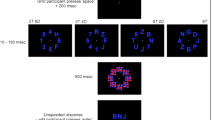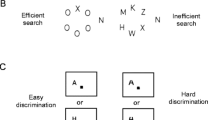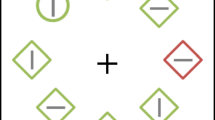Summary
The horizontal extent of the visual attentive field was measured by the use of a two-choice-RT task and compatible and incompatible distractors. The target was a line that inclined either to the left or to the right. Whether or not the subject performed the choice RT was made contingent upon whether two other stimuli presented in the visual display matched or mismatched. The match-mismatch stimuli varied in locations so as to manipulate the relevant visual area (the attended area). The locations of the distractors were also varied. The increase in RT associated with incompatible distractors was found to vary inversely with their distance from the edge of the area attended to and independently of their distance from the target lines. The results were interpreted in terms of an inhibitory field that surrounds the area attended to.
Similar content being viewed by others
References
Allport, D. A., Tipper, S. P., & Chmiel, N. (1985). Perceptual integration and post-categorical filtering. In M. Posner & O. S. M. Marin (Eds.),Attention and performance XI, pp. 107–132. Hillsdale, NJ: Erlbaum.
Broadbent, D. (1982). Task combination and the selective intake of information.Acta Psychologica, 50, 253–290.
Coles, M. G. H., Gratton, G., Bashore, T. R., Eriksen, C. W., & Donchin, E. (1985). A psychophysiological investigation of the continuous flow model of human information processing.Journal of Experimental Psychology: Human Perception and Performance, 11, 529–553.
Dalrymple-Alford, E. C., & Budayr, B. (1966). Examination of some aspects of the Stroop colour-word test.Perceptual and Motor Skills, 23, 1211–1214.
Driver, J., & Baylis, G. C. (1989). Movement and visual attention: The spotlight metaphor breaks down.Journal of Experimental Psychology: Human Perception and Performance, 15, 448–456.
Duncan, J. (1980). The locus of interference in the perception of simultaneous stimuli.Psychological Review, 87, 272–300.
Duncan, J. (1984). Selective attention and the organization of visual information.Journal of Experimental Psychology: General, 113, 501–517.
Eriksen, B. A., & Eriksen, C. W. (1974). Effects of noise letters upon the identification of a target letter in a nonsearch task.Perception & Psychophysics, 16, 143–149.
Eriksen, B. A., Eriksen, C. W., & Hoffman, J. E. (1986). Recognition memory and attentional selection: Serial scanning is not enough.Journal of Experimental Psychology: Human Perception and Performance, 12, 476–483.
Eriksen, C. W., Coles, M. G. H., Morris, L. R., & O'Hara, W. P. (1985). An electromyographic examination of response competition.Bulletin of the Psychonomic Society, 23, 165–168.
Eriksen, C. W., & Hoffman, J. E. (1973). The extent of processing of noise elements during selective encoding from visual displays.Perception & Psychophysics, 14, 155–160.
Eriksen, C. W., & Hoffman, J. E. (1974). Selective attention: Noise suppression or signal enhancement?Bulletin of the Psychonomic Society, 4, 587–589.
Eriksen, C. W., O'Hara, W. P., & Eriksen, B. A. (1982). Response competition effects in same-different judgments.Perception & Psychophysics, 32, 261–270.
Eriksen, C. W., & Rohrbaugh, J. (1970). Visual masking in multielement displays.Journal of Experimental Psychology, 83, 147–154.
Eriksen, C. W., & Schultz, D. W. (1977). Retinal locus and acuity in visual information processing.Bulletin of the Psychonomic Society, 9, 81–84.
Eriksen, C. W., & St James, J. D. (1986). Visual attention within and around the field of focal attention: A zoom lens model.Perception & Psychophysics, 40, 225–240.
Eriksen, C. W., & Yeh, Y.-Y. (1985). Allocation of attention in the visual field.Journal of Experimental Psychology: Human Perception & Performance, 11, 583–597.
Flowers, J. H. (1990). Priming effects in perceptual classification.Perception & Psychophysics, 47, 135–148.
Grice, G. R., Boroughs, J. M., & Canham, L. (1984). Temporal dynamics of associative interference and facilitation produced by visual context.Perception & Psychophysics, 36, 499–507.
Henderson, J. M., & Macquistan, A. D. (in press). The spatial distribution of attention following an exogenous cue.Perception & Psychophysics.
Hoffman, J. E., & Nelson, B. (1981). Spatial selectivity in visual search.Perception & Psychophysics, 30, 283–290.
Hoffman, J. E., Nelson, B., & Houck, M. R. (1983). The role of attentional resources in automatic detection.Cognitive Psychology, 15, 379–410.
Hughes, H. C., & Zimba, L. D. (1985). Spatial maps of directed visual attention.Journal of Experimental Psychology: Human Perception andPerformance, 11, 409–430.
Hughes, H. C., & Zimba, L. C. (1987). Natural boundaries for the spatial spread of directed visual attention.Neuropsychologia, 25, 5–18.
James, W. (1890/1950).The principles of psychology (Vol. 1), authorized edition. New York: Dover Publications, Inc.
Kahneman, D., & Henik, A. (1977). Effects of visual grouping on immediate recall and selective attention. In S. Dornic (Ed.),Attention and performance VII, pp. 307–332. Hillsdale, NJ: Erlbaum.
Kahneman, D., & Henik, A. (1981). Perceptual organization and attention. In M. Kubovy & J. R. Pomerantz (Eds.),Perceptual organization (pp. 181–211). Hillsdale, NJ: Erlbaum.
Kahneman, D., & Treisman, A. (1984). Changing views of attention and automaticity. In R. Parasuraman & R. Davies (Eds.), Varieties of attention (pp. 29–62). New York: Academic Press.
Keren, G., O'Hara, W. P., & Skelton, J. M. (1977). Levels of noise processing and attentional control.Journal ofExperimental Psychology: Human Perception and Performance, 3, 653–664.
Kramer, A. F., & Jacobson, A. (1991). Perceptual organization and focused attention: The role of objects and proximity in visual processing.Perception & Psychophysics, 50, 267–284.
Kramer, A. F., Tham, M. P., & Yeh, Y.-Y. (1991). Movement and focused attention: A failure to replicate.Perception & Psychophysics, 50, 537–546.
LaBerge, D. (1983). Spatial extent of attention to letters in words.Journal of Experimental Psychology: Human Perception and Performance, 9, 371–379.
LaBerge, D., & Brown, V. (1989). Theory of operations in shape identification.Psychological Review, 96, 101–124.
LaBerge, D., Brown, V., Carter, M., Bash, D., & Hartley, A. (1991). Reducing the effects of adjacent distractors by narrowing attention.Journal of Experimental Psychology: Human Perception and Performance, 17, 65–76.
Lowe, D. G. (1979). Strategies, context, and the mechanism of response inhibition.Memory & Cognition, 7, 382–389.
Lowe, D. G. (1985). Further investigations of inhibitory mechanisms in attention.Memory & Cognition, 13, 74–80.
Murphy, T. D., & Eriksen, C. W. (1987). Temporal changes in the distribution of attention in the visual field in response to precues.Perception & Psychophysics, 42, 576–586.
Navon, D. (1984). Resources — a theoretical soupstone?Psychological Review, 91, 216–234.
Navon, D. (1990). Does attention serve to integrate features?Psychological Review, 97, 453–459.
Neill, W. T. (1977). Inhibitory and facilitatory processes in selective attention.Journal of Experimental Psychology: Human Perception and Performance, 3, 444–450.
Neill, W. T., & Westberry, R. L. (1987). Selective attention and the suppression of cognitive noise.Journal of Experimental Psychology: Learning, Memory and Cognition, 13, 327–334.
Pan, K., & Eriksen, C. W. (1993). Attentional distribution in the visual field during same-different judgments as assessed by response competition.Perception & Psychophysics, 53, 134–144.
Shulman, G. L., Remington, R. W., & McLean, J. P. (1979). Moving attention through visual space.Journal of Experimental Psychology: Human Perception and Performance, 5, 522–526.
Tipper, S. P., MacQueen, G. M., & Brehaut, J. C. (1988). Negative priming between response modalities: Evidence for the central locus of inhibition in selective attention.Perception & Psychophysics, 43, 45–52.
Tsal, Y., & Lavie, N. (1988). Attending to color and shape: The special role of location in selective visual processing.Perception & Psychophysics, 44, 15–21.
Van der Heijden, A. H. C. (1992). Selective attention in vision. London/New York: Routledge.
Yantis, S., & Johnston, J. C. (1990). On the locus of visual selection: Evidence from focused attention tasks.Journal of Experimental Psychology: Human Perception and Performance, 16, 135–149.
Author information
Authors and Affiliations
Rights and permissions
About this article
Cite this article
Eriksen, C.W., Pan, K. & Botella, J. Attentional distribution in visual space. Psychol. Res 56, 5–13 (1993). https://doi.org/10.1007/BF00572128
Issue Date:
DOI: https://doi.org/10.1007/BF00572128




